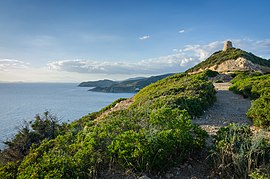Sinnai
| Sinnai | ||
|---|---|---|

|
|
|
| Country | Italy | |
| region | Sardinia | |
| Metropolitan city | Cagliari (CA) | |
| Local name | Sinnia | |
| Coordinates | 39 ° 18 ' N , 9 ° 12' E | |
| height | 133 m slm | |
| surface | 223.38 km² | |
| Residents | 17,664 (Dec. 31, 2019) | |
| Population density | 79 inhabitants / km² | |
| Post Code | 09048 | |
| prefix | 070 | |
| ISTAT number | 092080 | |
| Popular name | Sinnaesi | |
| Patron saint | Barbara of Nicomedia | |
| Website | Sinnai | |
 Capo Boi at Sinnai |
||
Sinnai is an Italian municipality ( comune ) with 17,664 inhabitants (as of December 31, 2019) in the metropolitan city of Cagliari in Sardinia . The municipality is located about 15 kilometers northeast of Cagliari .
As long as the residents are not employed as commuters in the Sardinian capital Cagliari, the economy is determined by agriculture.
history
Prehistory and early history
The oldest documented culture in the area of Sinnai is the late Neolithic Ozieri culture documented by Domus de Janas (S'Omu 'e S'Orcu and Santu Basileddu), menhirs and ceramics . There is also evidence of the cultures of Abealzu-Filigosa , Monte Claro and the bell beaker culture ( Italian Campaniforme ). Some glasses from "Is Ungronis" are ascribed to the Middle Bronze Age .
The Nuragic period is best documented: 56 nuraghi were found. Of these, three are protonuraghe , six are complex nuraghi and 47 are simple ( Italian monotorre ). There are nuragic settlements near the Pauli Mannu and Zinnibireddu nuraghi.
Other documented settlements are Is Cortis de Flumini, Funtan'e Meu, Is Ungronis, Sa Matt'e S'Illixi - Santa Barbara, Antonicu Ortu, S'Arrideli and Procileddu; while eight other settlements are known from surface finds. On the plain to the east of Sinnai there are many fountains from which Is Cortis de Flumini and Mitza Sa Murta could have come from the Nuragic period. However, an excavation must be carried out for an exact determination.
The 13 giant graves were often found in pairs. All of them consist of exedra made of worked blocks arranged in rows (Baiocca I and II, Berrittas, Funtana Landiri I and II, Maidopis, Sa Rocca Arrubia, Santa Itroxa I, Su Crabiolu, Taulaxa I and II and Zinnibireddu I , in the typical style of southern Sardinia and II). Two more are on Solanas beach and at the foot of Nuraghe Ferrici. Only a few blocks remain of Santa Itroxa II.
Of interest is the megalithic structure excavated at Bruncu Mogumu. The rectangular building located in a temenos is divided. The upper layers have released materials from the Nuragic Iron Age , some of which are painted with Greek-inspired geometric designs. The geographical location and the typology of the structure indicate that the building was used for ritual purposes.
Antiquity
The settlements Cratzieranu, Is Ischirrus, Maletta, Monte Turri are from the Punic and Roman periods; Papalinu and Portu Murvoni documented. Based on the surface finds, two dozen other settlements can be identified.
Community partnerships
Sinnai maintains internal partnerships with the following cities and municipalities:
- Armungia , South Sardegna Province
- Asiago , Vicenza Province
- Bovolone , Province of Verona
- Foza , Vicenza Province
- Tempio Pausania , Sassari Province
Web links
Individual evidence
- ↑ Statistiche demografiche ISTAT. Monthly population statistics of the Istituto Nazionale di Statistica , as of December 31 of 2019.

